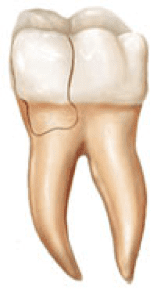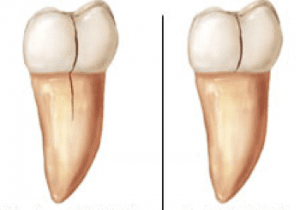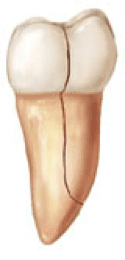Cracked Teeth
Cracked / Fractured Teeth
Whether your tooth cracks from an injury, clenching and grinding, or general wear and tear, you can experience a variety of symptoms ranging from erratic pain when you chew your food to sudden pain when your tooth is exposed to very hot or cold temperatures. In many cases, the pain may come and go and your dentist may have difficulty locating the tooth causing the discomfort.
As endodontists, we specialize in saving cracked teeth and will cater treatment to the type, location, and extent of the crack.
Listed below are categories of longitudinal fractures and their treatment recommendations:
Craze Lines
Craze lines are surface cracks of the enamel (the outer hard layer of tooth structure). Most adult teeth have these craze lines and no treatment is necessary as they typically pose no problems.

Fractured Cusp
When a part of the chewing surface of the tooth, called a cusp, is weakened by a crack it will often break off or be removed by the dentist (or endodontist). Many times a crown is all that is required to restore the tooth. Depending on the depth of the fracture and the presenting symptoms, a root canal may be required prior to returning to your dentist for a crown.
Cracked Tooth
 A “cracked tooth” can be difficult to diagnose. The fracture line usually starts from the middle of the chewing surface of the tooth and extends inward toward the pulp (or “nerve” of the tooth). Because this frequently involves injury to the pulp tissue, a root canal is often required before the tooth is restored with a crown. If the crack is extensive the tooth may need to be extracted (removed). Often it isn’t until the root canal is initiated that we know the true extent of certain types of cracks and whether the tooth can be saved.
A “cracked tooth” can be difficult to diagnose. The fracture line usually starts from the middle of the chewing surface of the tooth and extends inward toward the pulp (or “nerve” of the tooth). Because this frequently involves injury to the pulp tissue, a root canal is often required before the tooth is restored with a crown. If the crack is extensive the tooth may need to be extracted (removed). Often it isn’t until the root canal is initiated that we know the true extent of certain types of cracks and whether the tooth can be saved.
If the tooth can be saved with root canal treatment, it is critical to return to your dentist to restore the tooth with a crown as soon as possible. The purpose of the crown is to minimize the chances of further extent of the fracture.
Split Tooth
A split tooth is a cracked tooth that has extended to the point where there are separate segments (a.k.a., a complete fracture). A split tooth cannot be saved and requires extraction.

Vertical Root Fracture
Vertical root fractures start in the root of the tooth and extend toward the chewing surface of the tooth. They are usually painless and often discovered when the surrounding bone and gum become inflamed. Treatment usually involves extraction of the tooth. However, endodontic microsurgery can sometimes remove the portion of the root containing the fracture.
Understanding Cracked Tooth Symptoms and Treatment
Do you have a cracked tooth? Learn about the symptoms and how endodontists help patients avoid tooth extraction. It’s important to treat a cracked tooth quickly, so the problem doesn’t get worse.
